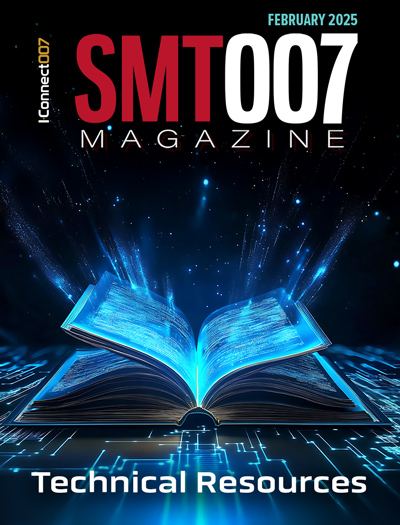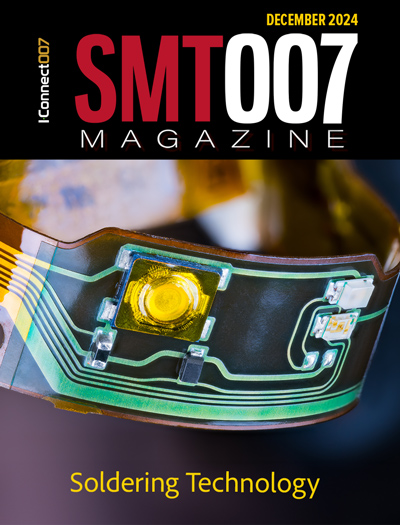-

- News
- Books
Featured Books
- smt007 Magazine
Latest Issues
Current Issue
Technical Resources
Key industry organizations–all with knowledge sharing as a part of their mission–share their technical repositories in this issue of SMT007 Magazine. Where can you find information critical to your work? Odds are, right here.

The Path Ahead
What are you paying the most attention to as we enter 2025? Find out what we learned when we asked that question. Join us as we explore five main themes in the new year.

Soldering Technologies
Soldering is the heartbeat of assembly, and new developments are taking place to match the rest of the innovation in electronics. There are tried-and-true technologies for soldering. But new challenges in packaging, materials, and sustainability may be putting this key step in flux.
- Articles
- Columns
Search Console
- Links
- Media kit
||| MENU - smt007 Magazine
ODMs Slow Stocking; 4Q24 MLCC Shipments Expected to Decline by 3.6%
October 8, 2024 | TrendForceEstimated reading time: 2 minutes
TrendForce’s latest findings show that recent economic data points to a steady cooling of inflation in the US market, prompting the Federal Reserve to cut interest rates by 50 basis points in September to prevent a potential economic slowdown or recession. Additionally, the complex geopolitical landscape and uncertainties surrounding the US presidential election could dampen consumer spending, posing a significant risk to year-end holiday demand. Consequently, TrendForce forecasts that total shipments of MLCCs will reach approximately 1.205 trillion units in 4Q24—representing a quarterly decline of 3.6%.
Smartphones and notebooks see conservative demand, but AI server growth remains robust, benefiting Japanese and Korean suppliers
TrendForce notes that order forecasts for Q4 notebooks from ODMs have decreased by an average of 5% to 8%. ODMs have taken a cautious approach to component stocking since mid-September due to conservative planning by OEMs for orders related to smartphones, notebooks, networking equipment, and tablets. Their stocking attitudes remain reserved even in light of the Chinese National Day holiday and the upcoming holiday shopping season in Europe and the US.
While there has been a slight increase in demand for business notebooks and Huawei’s new foldable smartphone, Apple’s recently launched AI-enabled iPhone 16 has yet to generate a significant replacement cycle. The newly introduced Apple Intelligence still requires time to mature in its applications.
In contrast, demand for AI servers continues to gain momentum. Although NVIDIA’s Blackwell GPUs have faced production delays until mid-Q4 due to adjustments to mask-design, orders for Hopper-based H100/H200 GPUs have increased by 65%, and demand for the scaled-down H20 GPU variant has risen by 33%. This trend has simultaneously driven increased demand for US-based CSPs for 400G Switches and from AWS for AI accelerator cards using Annapurna network chips.
Consequently, some network manufacturers have seen their order forecast for Q4 grow by nearly 15%. TrendForce reports that the demand for high-end MLCCs in Q4 remains stable, allowing Japanese and Korean suppliers to better plan their capacity allocations in preparation for a surge in GB200 orders next year.
Weaker dollar and strengthening Asian currencies increase MLCC suppliers’ operational and pricing pressures
The US dollar has weakened due to the Federal Reserve initiating a rate-cut cycle, leading to a rise in Asian currencies. The Japanese yen, in particular, broke the 140 yen-to-1 dollar mark in mid-September. TrendForce reveals that MLCC suppliers not only facing weaker demand in Q4 but also increased risks of foreign exchange losses, further adding to their operational pressures. In response, suppliers are planning to control capacity utilization rates and lower inventory levels to stabilize product pricing and maintain revenue and profitability.
TrendForce’s investigations show that the average capacity utilization rates for Japanese and Korean suppliers remain above 80%, while Taiwanese and Chinese manufacturers are operating at a more modest 60% to 70%. Suppliers have adopted a more cautious approach to operations and pricing strategies with the peak season in the second half of the year falling short of expectations and fourth quarter demand slowing down.
Suggested Items
Gaming Monitor Panel Growth to Slow in 2025—LCD Up 5%, OLED Up 40%
02/19/2025 | TrendForceTrendForce’s latest investigations reveal that global LCD gaming monitor panel shipments (>144 Hz) reached 32.42 million units in 2024, marking a 12% YoY increase. However, due to a lack of major demand catalysts and struggling profitability in mainstream gaming monitors, 2025 shipments are expected to grow at a slower rate of 5%, reaching approximately 34 million units.
Supplier Production Cuts and AI Demand Expected to Drive NAND Flash Price Recovery in 2H25
02/17/2025 | TrendForceTrendForce's latest findings reveal that the NAND Flash market continues to be plagued by oversupply in the first quarter of 2025, leading to sustained price declines and financial strain for suppliers.
Multilayer PCB Market to Reach $116.1B by 2032 at 5.5% CAGR: Allied Market Research
02/12/2025 | Globe NewswireAccording to the report, the "multilayer printed circuit board market" was valued at $71 billion in 2023, and is estimated to reach $116.1 billion by 2032, growing at a CAGR of 5.5% from 2024 to 2032.
Mycronic Reports Strong Fourth Quarter and Record Full-Year Results
02/06/2025 | MycronicMycronic today reported strong fourth-quarter results, with order intake increasing 64 percent to SEK 2,381 million.
Scanfil Expands SRX Malaysia with €4.3M Investment for New Production Lines
01/31/2025 | ScanfilScanfil, a leading provider of electronics manufacturing services (EMS), announced a €4.3 million investment in SRX Malaysia to expand its production capacity and meet the growing demand for its services.


